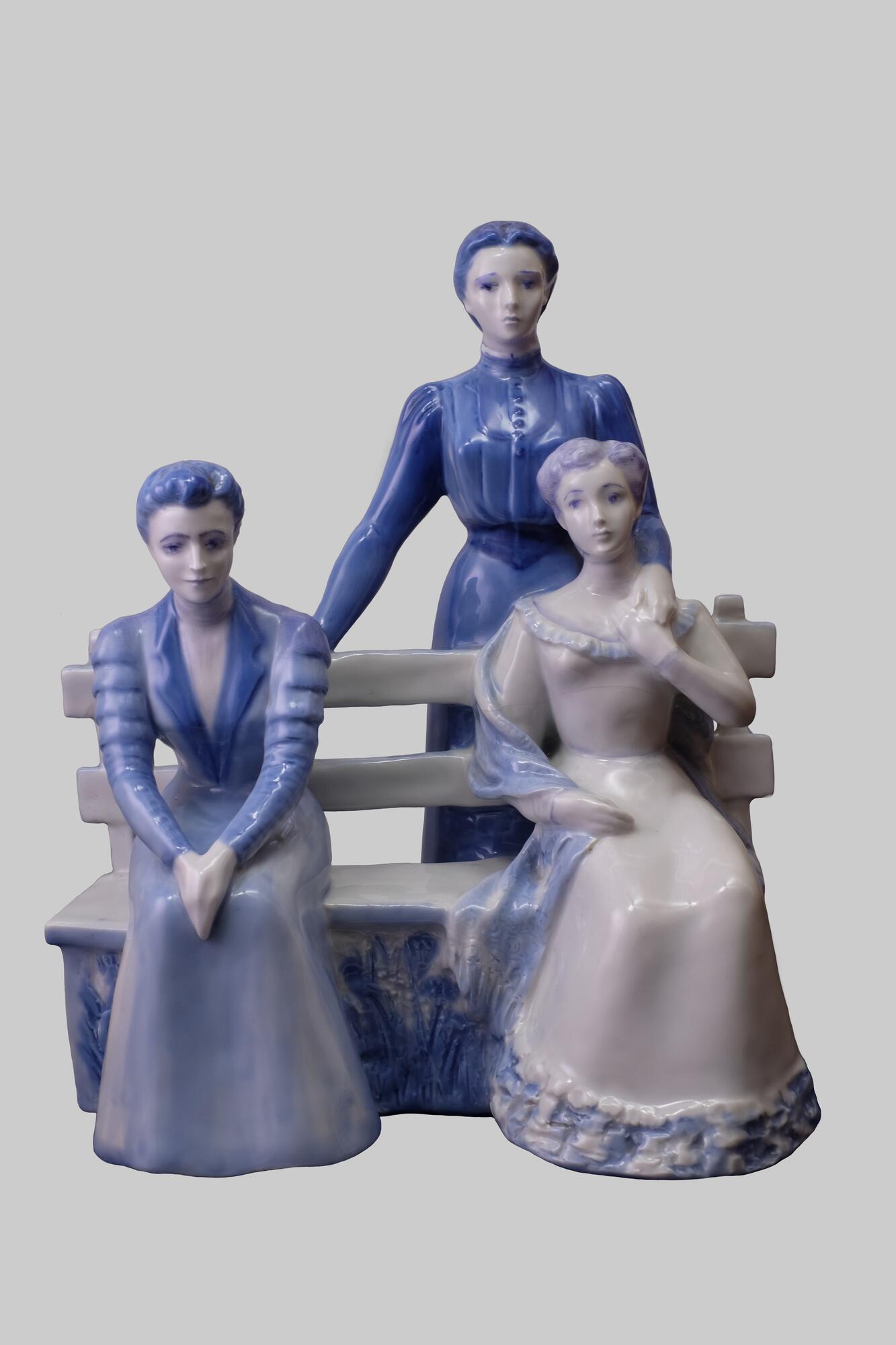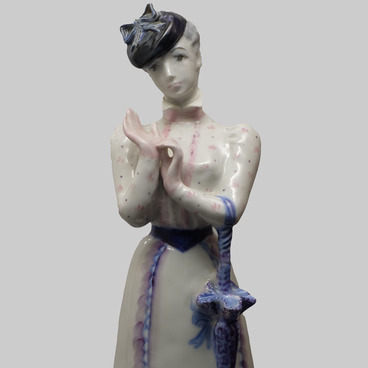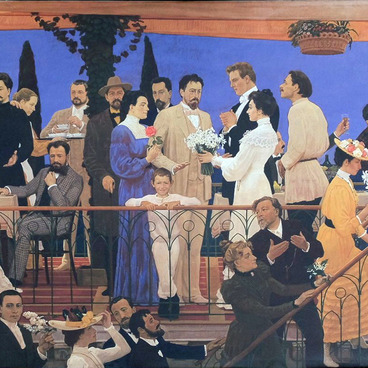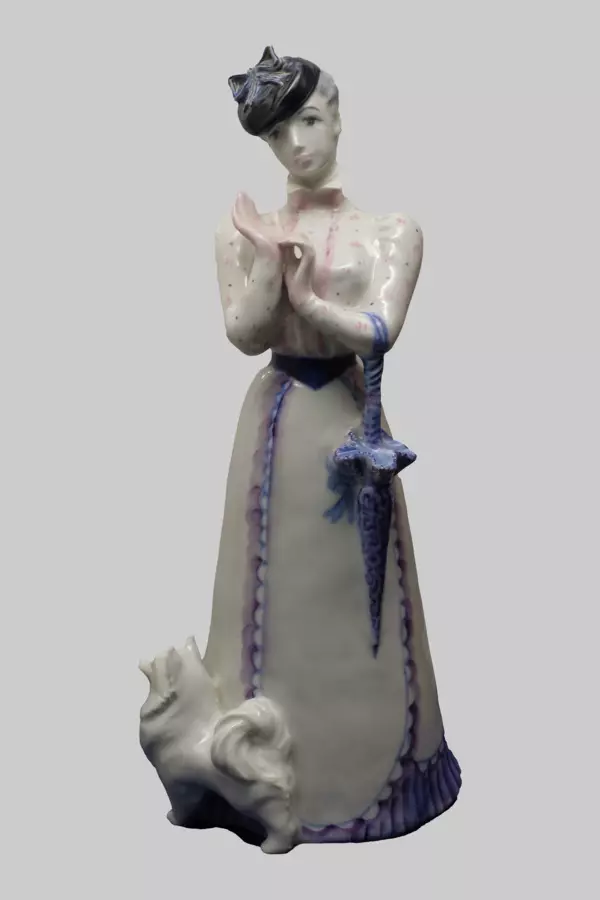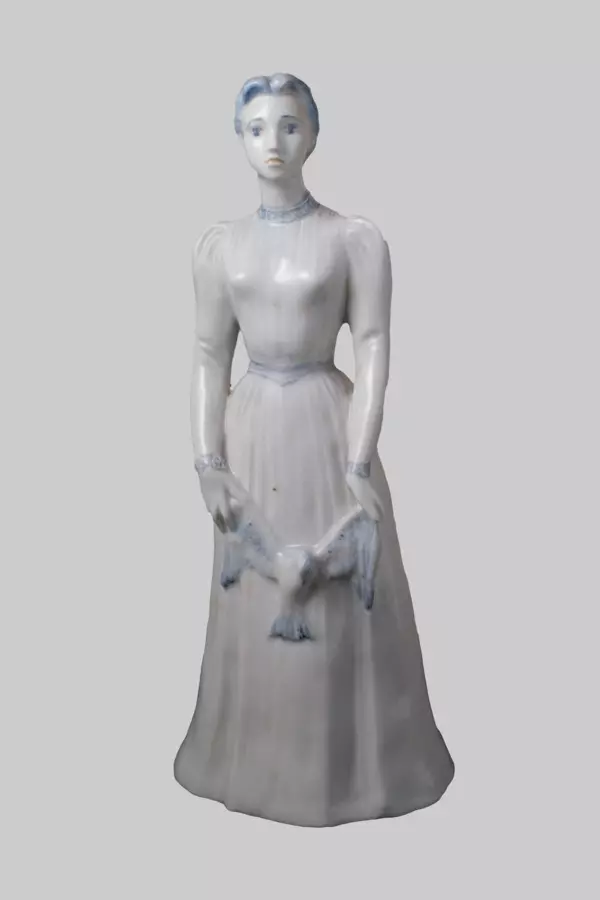The decorative composition displayed behind the glass captured the actresses of the Moscow Art Theater in the finale of Anton Pavlovich Chekhov’s play “The three Sisters”. The statuette was made by the sculptor Asta Davydovna Březitskaya (1912-2004).
Asta Davydovna, along with other sculptors Nina Aleksandrovna Malysheva (1914-1983) and Evgenia Ilinichna Gatilova (born September 19, 1921), took part in a creativity competition to create compositions in porcelain for the works of Anton Pavlovich Chekhov. All three were employees of the Dulevo Porcelain Factory. Březitskaya and Gatilova were awarded diplomas and the third prize for the series “Based on the works written by A. Chekhov in Melikhovo.” Asta Davydovna’s diaries contain memories of how the work on the characters progressed. In addition to the ‘Three Sisters’, she prepared ‘The Man in the Case’, ‘The Lady with the Dog’, ‘Ionych’, ‘Kashtanka’ and ‘Cherry Orchard’ for the competition.
Asta Davydovna worked at the Dulevo factory for more than 50 years. In her hands, the characters of the works of classic writers were born. In the sculptural composition ‘The three Sisters’ we recognize the famous artists of the Moscow Art Theater who played the heroines on stage.
Olga Leonardovna Knipper-Chekhova (Masha) and Nina Nikolaevna Litovtseva (Irina) sit on a bench. In the background, with her hands on the back, stands Margarita Georgievna Savitskaya (Olga). The composition was cast at the Moscow Experimental Production Plant of Monumental and Decorative Sculpture. The ‘sole’ of the figurine contains three technological holes, next to which is the author’s signature “A. Br. "
The premiere performance, staged by Stanislavsky and Nemirovich-Danchenko, was set on January 31, 1901 on the Moscow stage. After giving seven performances in Moscow, the troupe went on tour to St. Petersburg. The theater audience of St. Petersburg greeted the new performance of the Moscow Art Theater with rave reviews. Critics tried to cool the ardor of fans, but their voices were not heard by the capital’s theatergoers. Chekhov received letters from fans, in which it was said that after watching the play they " wanted to live, to write, to work.’
Asta Davydovna, along with other sculptors Nina Aleksandrovna Malysheva (1914-1983) and Evgenia Ilinichna Gatilova (born September 19, 1921), took part in a creativity competition to create compositions in porcelain for the works of Anton Pavlovich Chekhov. All three were employees of the Dulevo Porcelain Factory. Březitskaya and Gatilova were awarded diplomas and the third prize for the series “Based on the works written by A. Chekhov in Melikhovo.” Asta Davydovna’s diaries contain memories of how the work on the characters progressed. In addition to the ‘Three Sisters’, she prepared ‘The Man in the Case’, ‘The Lady with the Dog’, ‘Ionych’, ‘Kashtanka’ and ‘Cherry Orchard’ for the competition.
Asta Davydovna worked at the Dulevo factory for more than 50 years. In her hands, the characters of the works of classic writers were born. In the sculptural composition ‘The three Sisters’ we recognize the famous artists of the Moscow Art Theater who played the heroines on stage.
Olga Leonardovna Knipper-Chekhova (Masha) and Nina Nikolaevna Litovtseva (Irina) sit on a bench. In the background, with her hands on the back, stands Margarita Georgievna Savitskaya (Olga). The composition was cast at the Moscow Experimental Production Plant of Monumental and Decorative Sculpture. The ‘sole’ of the figurine contains three technological holes, next to which is the author’s signature “A. Br. "
The premiere performance, staged by Stanislavsky and Nemirovich-Danchenko, was set on January 31, 1901 on the Moscow stage. After giving seven performances in Moscow, the troupe went on tour to St. Petersburg. The theater audience of St. Petersburg greeted the new performance of the Moscow Art Theater with rave reviews. Critics tried to cool the ardor of fans, but their voices were not heard by the capital’s theatergoers. Chekhov received letters from fans, in which it was said that after watching the play they " wanted to live, to write, to work.’
